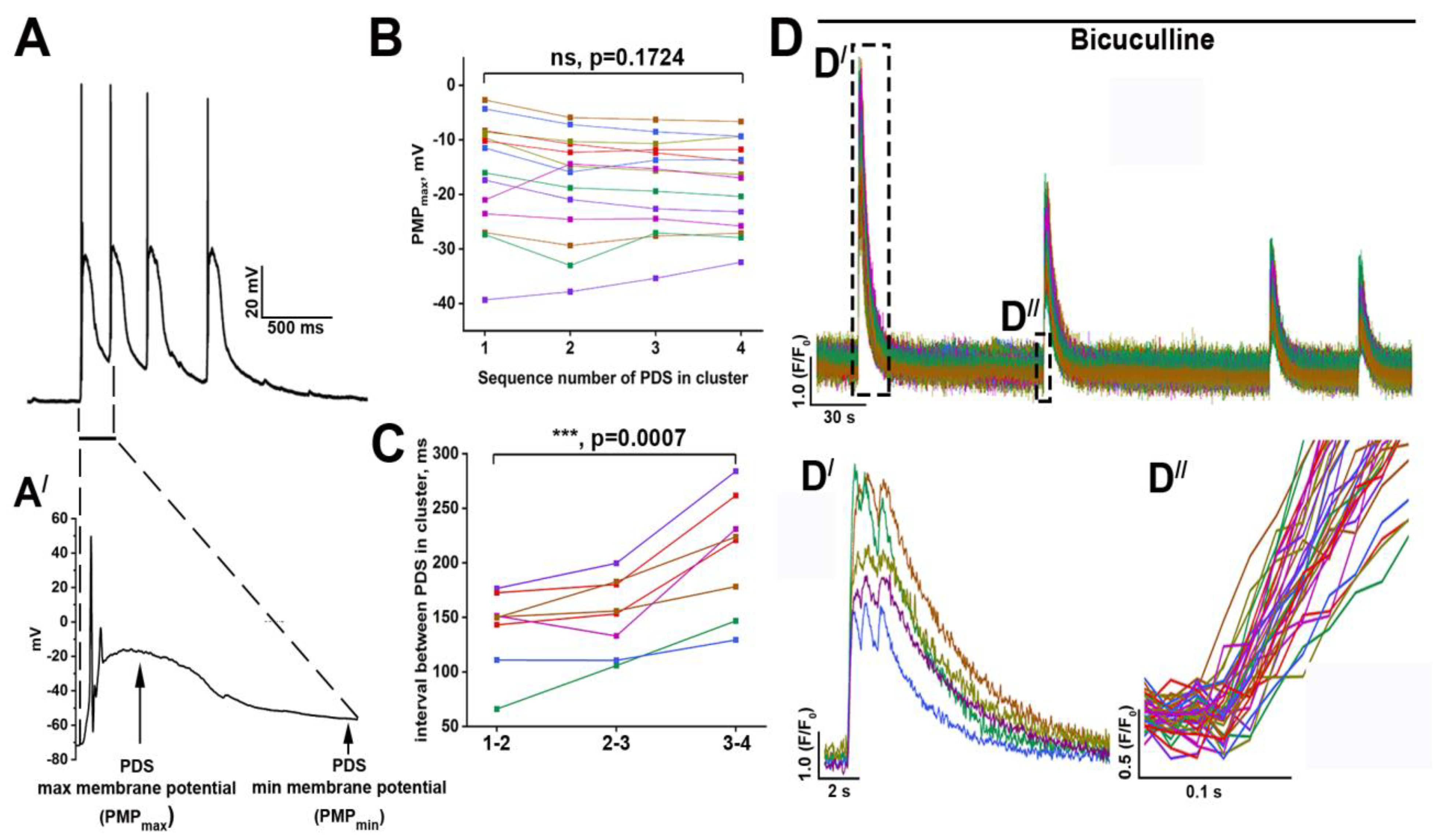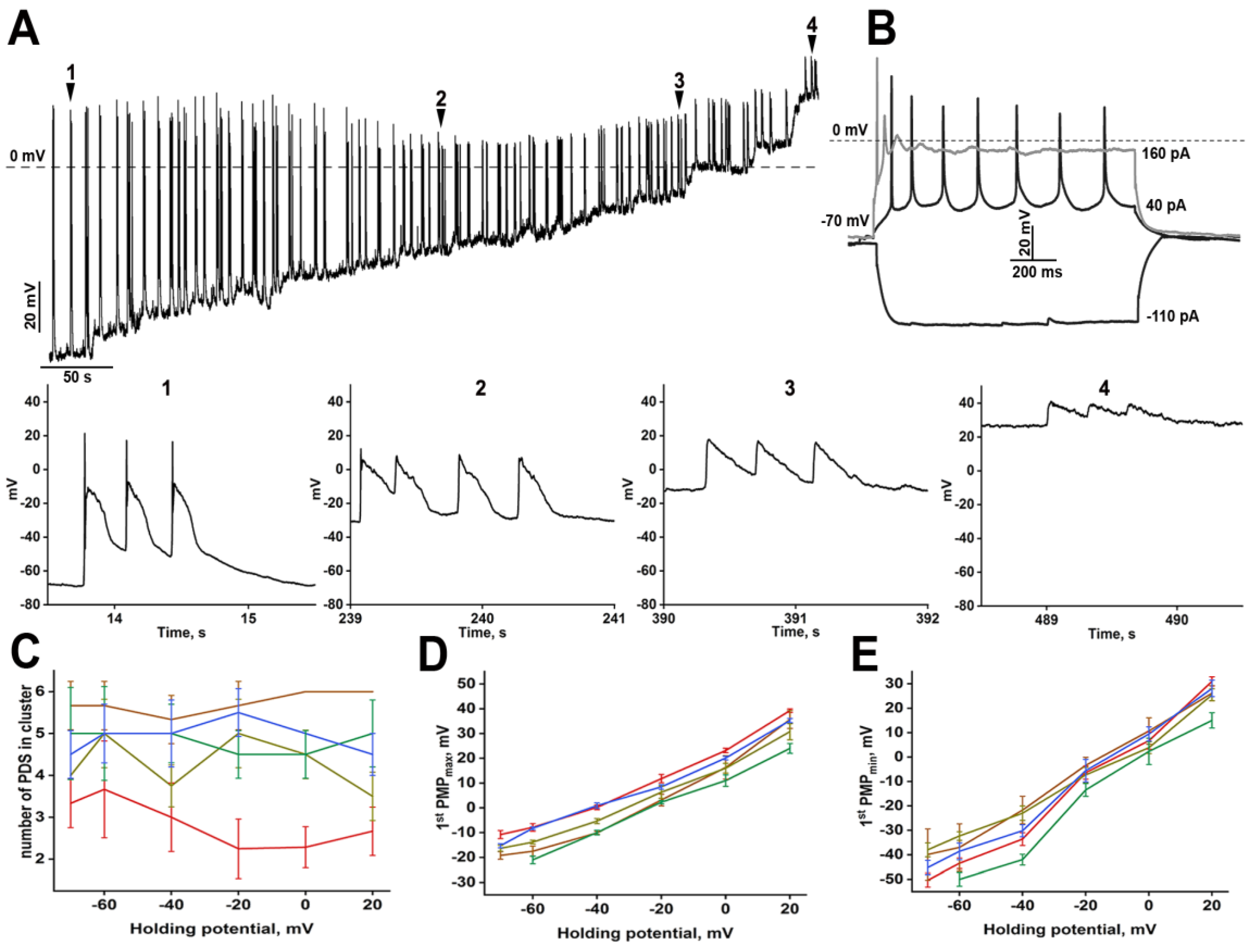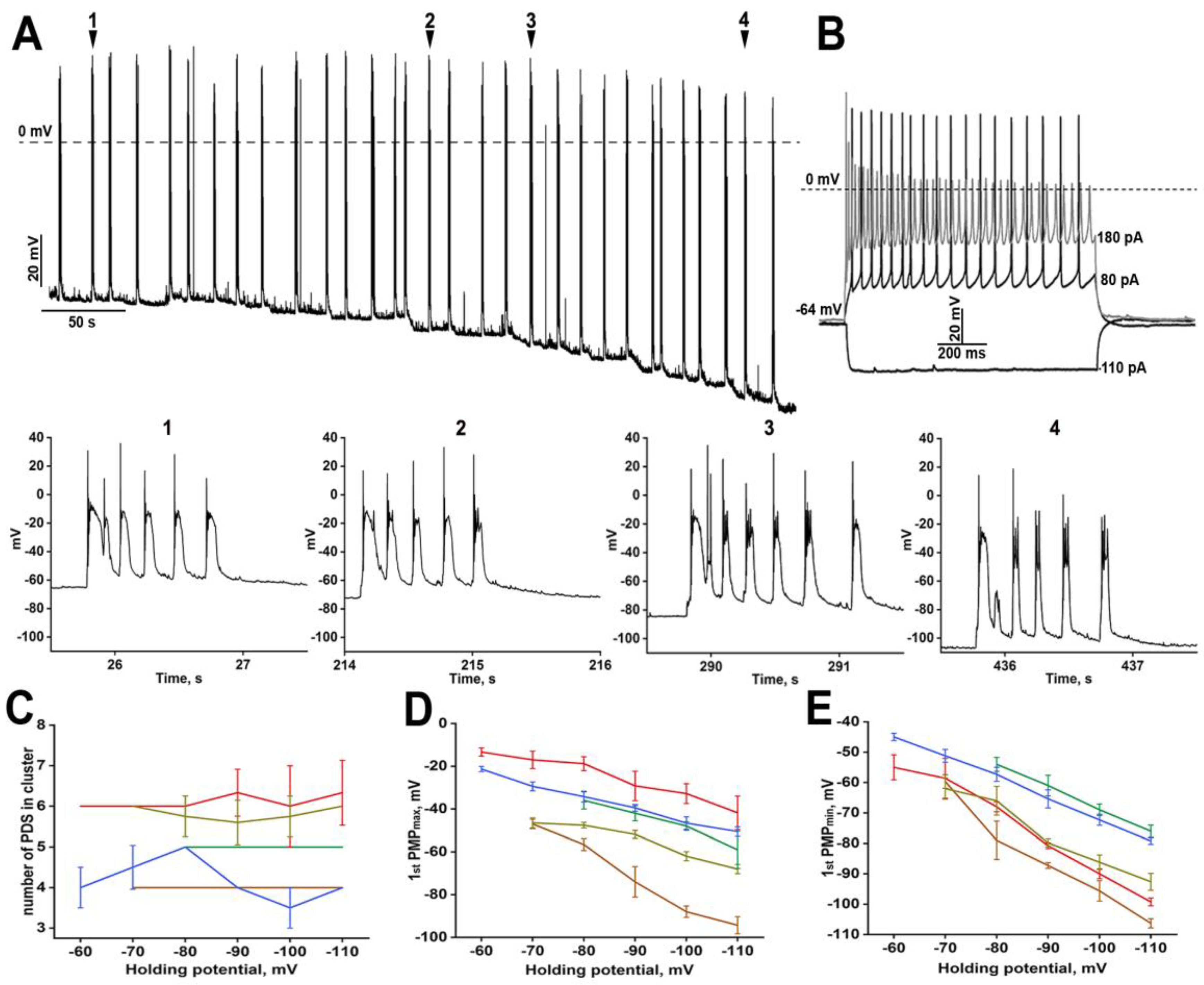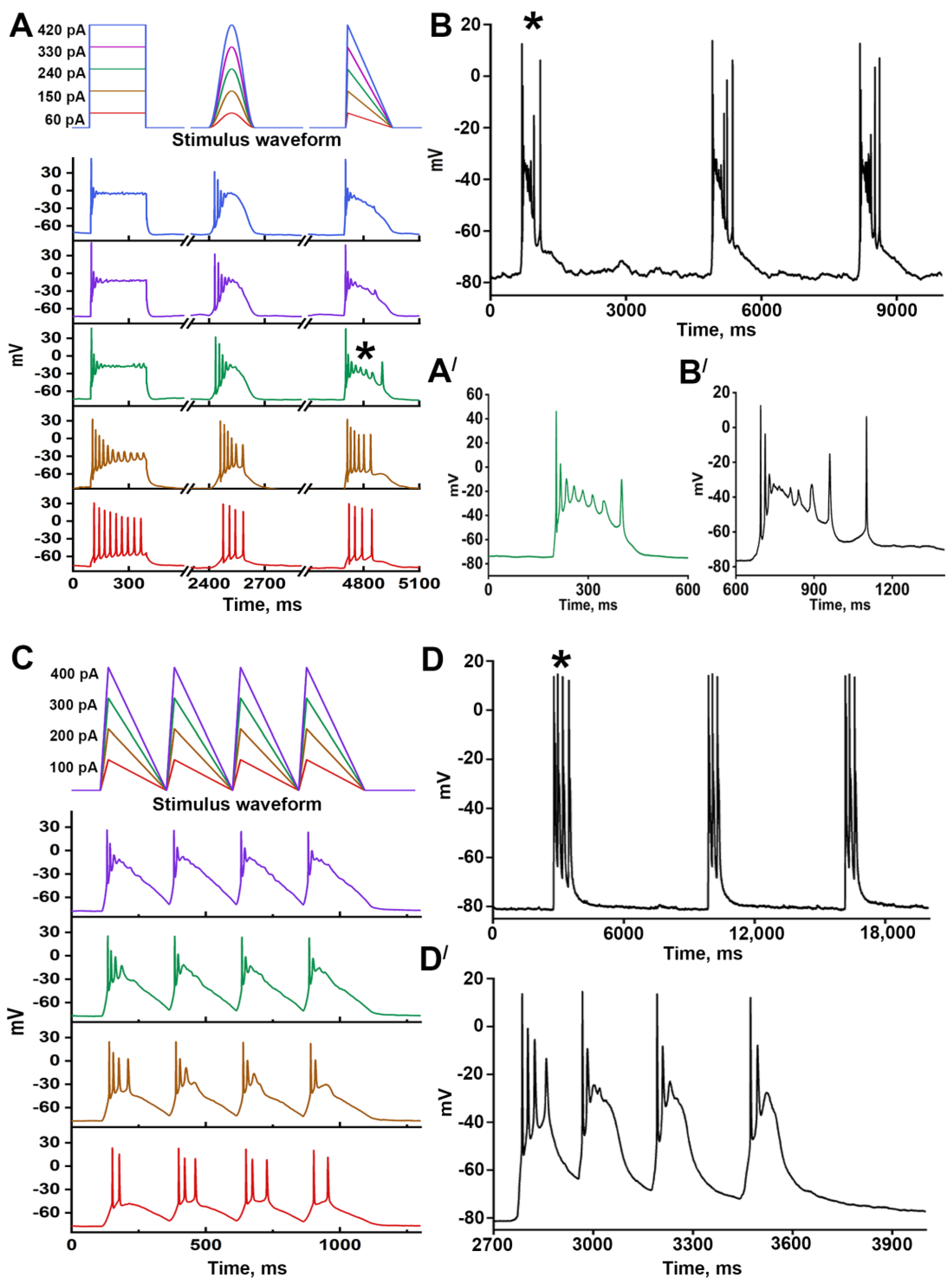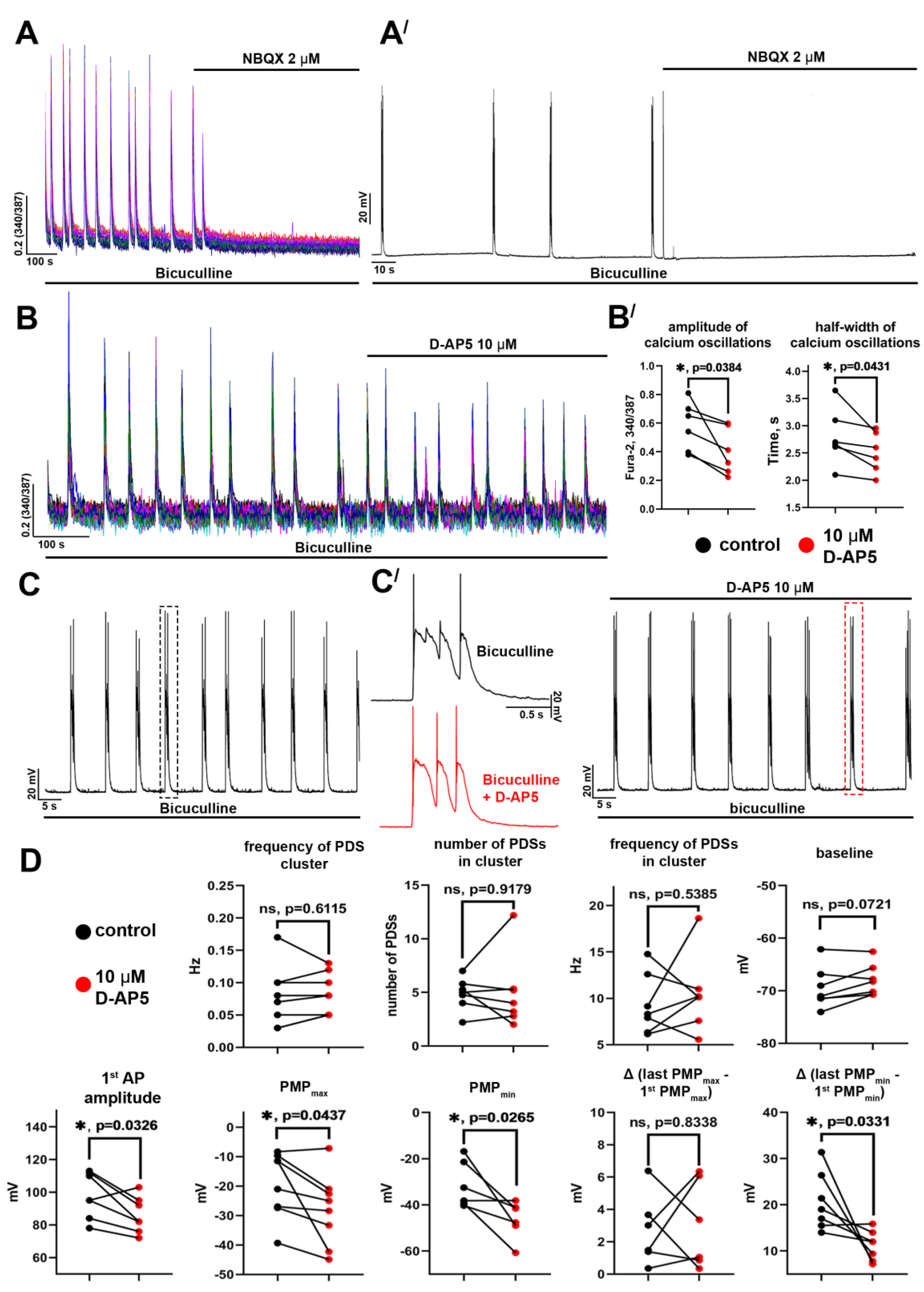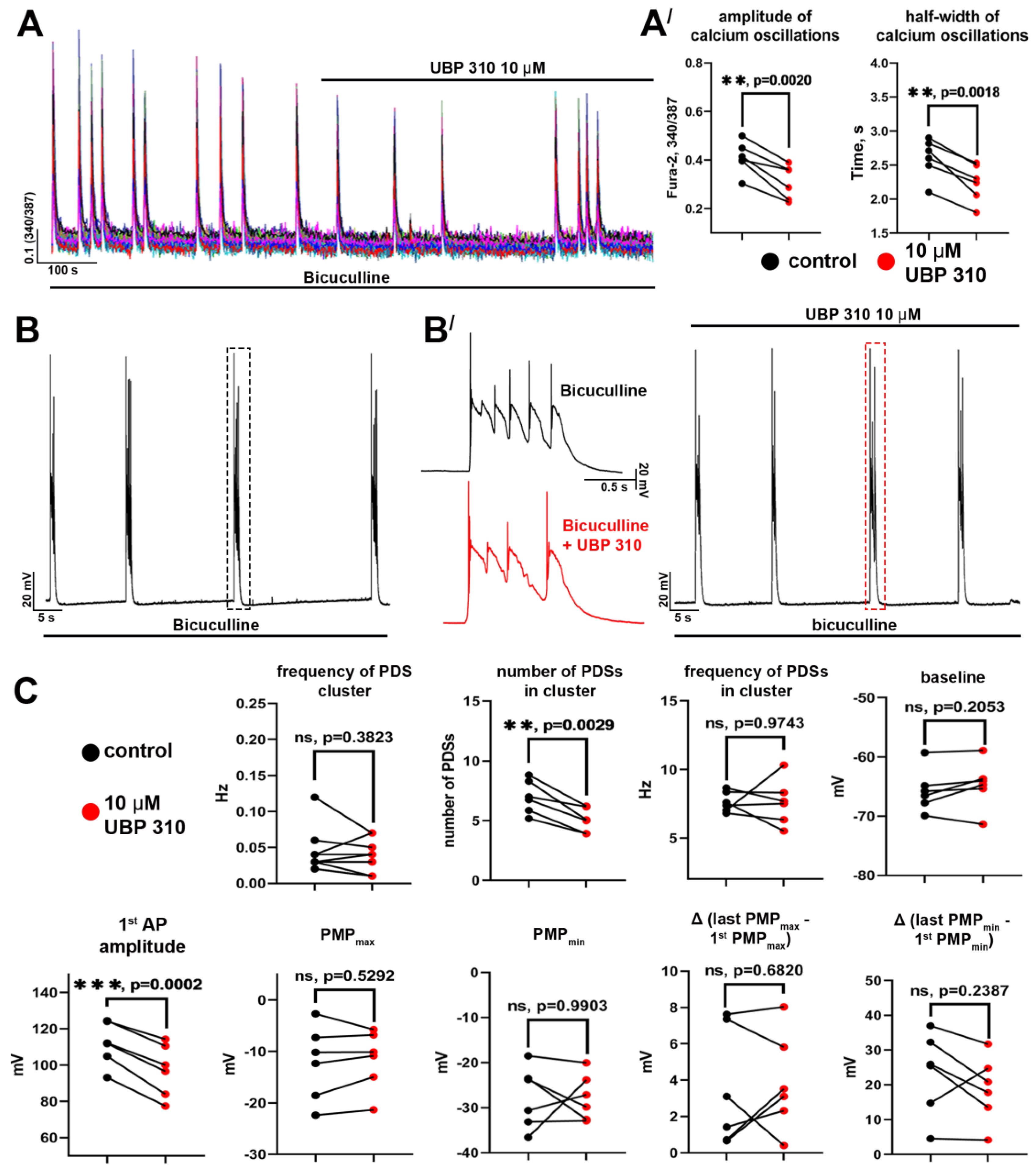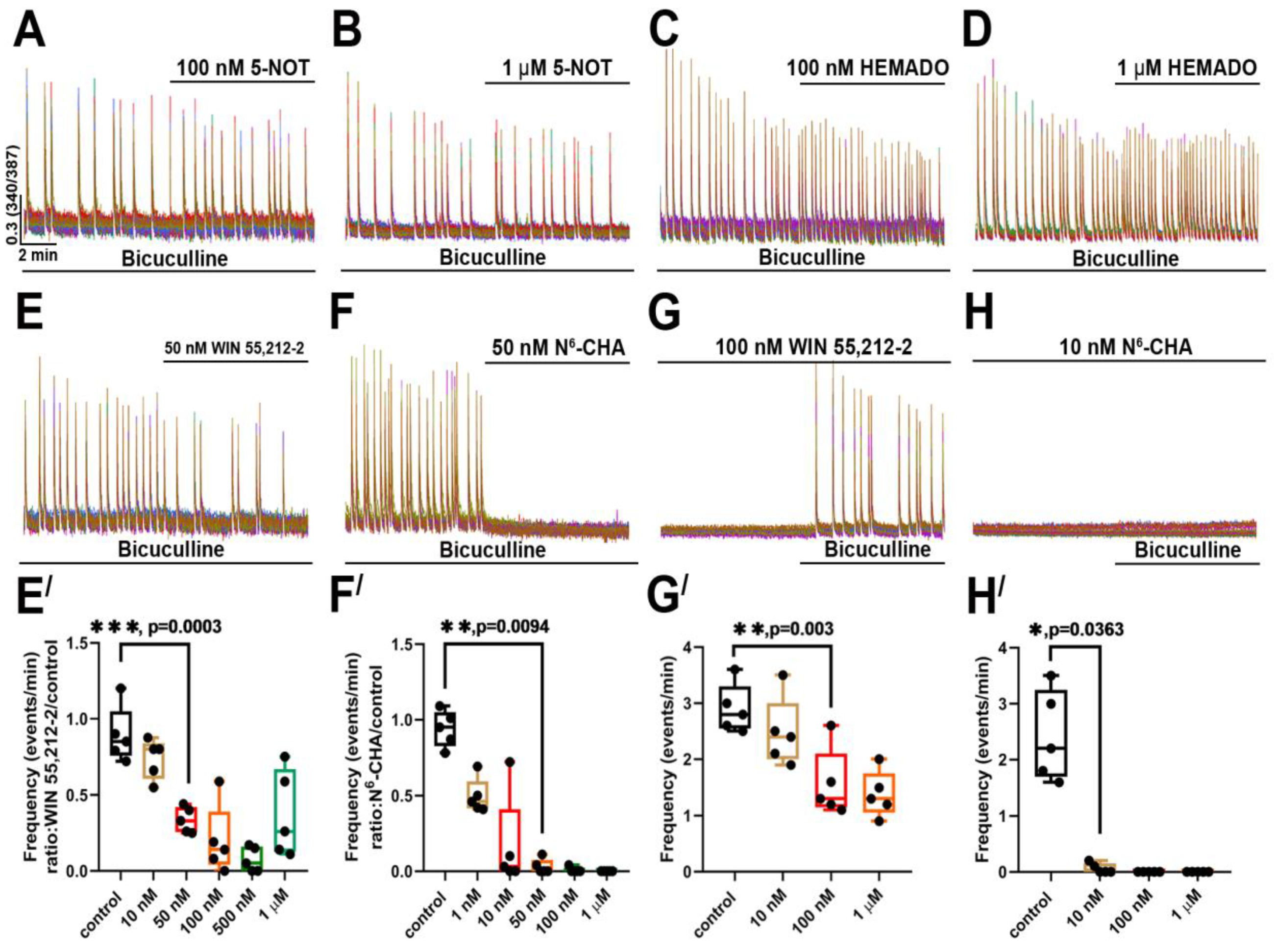1. Introduction
Paroxysmal depolarization shift (PDS) is a prolonged (hundreds of milliseconds) depolarization of neuronal membrane potential by 20–70 mV occurring as a single event or as a cluster consisting of some PDSs [
1]. PDS is assumed to be a neuronal correlate of the interictal spikes (IISs) detected with electroencephalography in the periods between epileptic discharges. Although the PDSs were first described in the 1970s, some important questions remain unanswered: (1) What is the role of PDSs in epileptogenesis? (2) Is PDS a manifestation of the intrinsic activity of a single neuron? (3) What mechanisms underlie the association of PDSs into clusters? (4) What factors determine the frequency and duration of individual PDSs and especially PDS clusters? Using rat hippocampal neuron-glial cell cultures, we have tried to address some of these questions in our present study.
The analysis of the literature data revealed that the role of PDSs/IISs in epilepsy is debatable since two opposite hypotheses have been formulated. According to the first one, IISs enhance the formation of abnormal connections, thus making the neuronal networks more excitable and promoting epileptogenesis [
2,
3]. According to the alternative hypothesis, IISs occur independently on ictal spikes and may decrease the inclination to seizures [
4]. It may be possible that both hypotheses are true, but only for particular conditions and different time intervals.
The generation of PDS accompanies IIS in a large number of neurons firing synchronously. Many distinct mechanisms, including communications via gap junctions, ephaptic interactions, and excitatory neurotransmission mediated by ionotropic glutamate receptors (iGluRs), such as NMDA and AMPA receptors (NMDARs and AMPARs, respectively), underlie the powerful synchronization of neurons [
1,
5]. It has been shown that antagonists of NMDARs and AMPARs partially or entirely suppressed the paroxysmal activity [
6,
7,
8], whereas the role of kainate receptors (KARs) remains unknown. L-type voltage-gated calcium channels also significantly pattern PDSs. These channels determine the paroxysmal shift duration and the number of individual PDSs in a cluster [
9,
10]. Interestingly, the contribution of other voltage-gated channels has been poorly studied, which may be explained by the absence of a standard, reliable model of paroxysmal activity induction, including specific stimulation protocols.
Different metabotropic receptors are considered the targets for the therapy of neurological diseases, including epilepsy. G-protein-coupled receptors are metabotropic receptors whose functions are determined by the type of associated G-protein. G-proteins consist of alpha (α) and beta-gamma subunits (βγ). They are divided into three main families based on the sequence similarity of the alpha subunits: G
s-, G
q-, and G
i-proteins [
11]. G
i-coupled receptors are of great interest in terms of epilepsy treatment since their activation induces a decrease in neuronal activity. Members of this family present in all classes of receptors to main neuromodulators, including dopaminergic, serotoninergic, adenosine, and cannabinoid receptors [
12]. Activation of G
i-coupled receptors results in adenylyl cyclase inhibition followed by a decrease in intracellular cyclic adenosine monophosphate (cAMP) level. Interestingly, βγ- but not α subunit mediates the changes in ion channel activity, thus causing a decrease in intrinsic neuronal excitability and network activity due to attenuation of neurotransmitter release.
In this study, we demonstrate the role of membrane potential and the contribution of iGluRs (especially kainate receptors) in the generation of single PDSs and PDS clusters in the model of bicuculline-induced paroxysmal activity, and discuss the mechanisms underlying the PDS induction. We also demonstrate the effects of agonists of different classes of Gi-coupled receptors on paroxysmal activity.
3. Discussion
The paroxysmal activity of neurons can be induced in different ways, including the application of GABA(A)Rs antagonists, the elevation of extracellular K
+ concentration, or a decrease in extracellular Mg
2+ or Ca
2+ concentration [
14]. The shift of E/I balance towards excitation and further hypersynchronization of neuronal activity occurs in all these models. According to computer models, activation of several glutamatergic neurons is sufficient to induce paroxysmal activity in the whole network [
15]. Interestingly, astrocytes are also involved in paroxysmal activity induction. It has been shown that PDSs in neurons are followed by depolarization and [Ca
2+]
i elevations in astrocytes. Photolytic Ca
2+ uncaging or IP
3 infusion resulted in glutamate release from astrocytes and generation of PDSs in neighboring neurons [
14,
16]. Mathematical models confirm that astrocytes can induce or enhance paroxysmal activity [
17]. Additionally, glutamate released by astrocytes is known to synchronize PDSs in neurons [
16]. However, as we have previously shown, tonic glutamate release by astrocytes does not occur in rat neuron-glial hippocampal cultures grown in Neurobasal-A+B27 medium, even in the presence of bicuculline [
18].
Hypersynchronization of neuronal networks is likely mediated by the synaptic and non-synaptic mechanisms, such as ephaptic interactions [
19]. Glutamate secretion and further activation of postsynaptic NMDARs, AMPARs, and KARs can be considered an example of synaptic mechanisms. According to our experiments, AMPARs fulfill an essential role in maintaining paroxysmal activity since the blockade of these receptors results in complete suppression of PDSs in all neurons. Activation of NMDARs following activation of AMPARs provides additional ion influx, thus enhancing input neuronal stimulation and increasing the maximal amplitude of the depolarizing shift. We have first demonstrated the contribution of GluK1-containing KARs to paroxysmal activity. The blockade of KARs reduced the number of PDSs in the cluster insignificantly, affecting 1st AP amplitude and the number of PDSs in a cluster. This effect seems unexpected at first glance since expression of GluK1-containing KARs has been reported for GABAergic neurons [
13,
20]. Therefore, activation of these receptors should have induced GABA secretion and suppressed network activity, whereas the blockade, on the contrary, should have promoted excitation of the network. However, we observed the opposite effect. The peculiarities of the used model of paroxysmal activity may explain the described differences. As mentioned above, we used the competitive antagonist of GABA(A)Rs, bicuculline, to induce paroxysmal activity. The effects of GABA are mediated only by GABA(B)Rs in this case because bicuculline suppresses the activity of GABA(A)Rs. Although GluK1-containing receptors are predominantly expressed by GABAergic neurons, GluK1 homomers and heteromers also localize at pre- and postsynaptic terminals of glutamatergic neurons [
20,
21]. Thus, the KAR antagonist most likely suppresses glutamate release, reducing the number of PDSs in the cluster this way.
In the close (self-contained) neuronal networks, extracellular stimulus inducing PDS generation has most likely a triangular shape. This conclusion has been drawn from the experiments shown in
Figure 5. Most of the voltage-gated sodium and calcium channels are inactivated, whereas the conductivity of potassium channels is minimal at membrane potential close to 0 mV. The pattern of the depolarizing shift is primarily determined by iGluRs under these conditions [
22,
23]. The depolarizing signal is characterized by a fast rise followed by uniform, almost linear decay. This pattern reflects the changes in extracellular glutamate concentration. Barnes and coauthors have demonstrated that the dynamics of extracellular glutamate concentration upon powerful stimulation also has triangular-shape kinetics. Its duration corresponds to the duration of a single PDS [
24]. Our experiments with triangle-shaped stimulation mimicking paroxysmal depolarization confirm this assumption. Based on this consideration, we can conclude that although the external depolarizing stimulus has a triangular shape and is mediated by the changes in glutamate concentration, the PDS pattern that we have observed in experiments is determined by the intrinsic properties of a neuron. For instance, voltage-gated sodium and high-threshold calcium channels are known to enhance initial iGluRs-mediated depolarization [
25]. Additionally, Ca
2+-activated potassium channels and voltage-gated L-type calcium channels modulate the amplitude and duration of a PDS [
9,
25]. In turn, the potassium channels shape the hyperpolarizing component of PDS [
25,
26]. Intrinsic electrophysiological properties of neurons, particularly their ability to generate high-frequency spikes, determine the number of APs occurring during PDS. The number of these APs depends on the amplitude of the depolarizing stimulus because the number of spikes that a particular neuron can generate is determined by membrane potential. Each PDS is terminated due to the activity of the potassium channels and the depletion of extracellular glutamate. The glutamate concentration in a synaptic cleft depends on the intensity of its secretion from a presynaptic terminal and the rate of uptake by neuronal and especially astrocytic glutamate transporters. Moreover, the GABA transporters, which compensate for the excitatory action of glutamate by governing GABA concentration, are also crucial in this case. Although the volume of ‘extracellular space’ in 2D cell cultures significantly differs from the native brain (large volume of the extracellular medium above the monolayer), the fundamental mechanisms underlying the maintenance of synaptic glutamate/GABA concentration are similar in both models. The similarity of the kinetics of glutamate concentration in the brain under pathological conditions and the pattern of paroxysmal depolarization (triangle shape) in our model may indirectly confirm this hypothesis. Each new PDS during the cluster occurs when membrane potential in the group of initiative neurons is sufficient to overcome the AP threshold, and the generated spikes trigger simultaneous synchronous glutamate release. It has been shown that membrane hyperpolarization followed by slow repolarization occurs in the initiative neurons after PDS [
10,
15]. The depolarization rate obviously determines the interval between PDSs. It may be possible that this rate depends on the intrinsic properties of neurons and external factors, such as the rate of restoration of extracellular ion balance, particularly K
+ concentration, which is regulated by the activity of astrocytes [
14,
15].
The mechanisms underlying the integration of several PDSs into clusters remain unknown. Our experiments show that duration and PMP
max values are similar for individual PDSs in the cluster. However, the intervals between consecutive PDSs increase during the cluster. We did not find reliable markers in electrophysiological recordings demonstrating whether a particular PDS is the last or whether others can follow it. Considering that the external input stimulus causes each PDS in the cluster, it may be suggested that all PDSs following the first occur in response to glutamate release. Thus, an unrevealed factor promotes several powerful glutamate effluxes during the short interval. High-frequency recordings (
Figure 1) demonstrate that PDSs are followed by the quasi-synchronous [Ca
2+]
i elevations consisting of some peaks. The number of peaks corresponds to the number of PDSs in the cluster; therefore, this number is similar for all neurons, at least in a viewfield. It should be noted that the [Ca
2+]
i level remains high in the periods between the peaks. In this regard, a significant increase in [Ca
2+]
i during the first PDS might be considered as the factor promoting repetitive glutamate release and consecutive generation of PDSs. This hypothesis is supported by the experiments where the blockade of L-type voltage-gated calcium channels profoundly reduces the number of PDSs in the cluster, insignificantly affecting the structure of individual PDSs [
10]. Similarly, the blockade of GluK1-containing KARs that may be Ca
2+-permeable [
27] also reduces the amplitude of [Ca
2+]
i oscillations and the number of PDSs in the cluster. However, the NMDAR blockade, followed by a decrease in the amplitude of the oscillations, did not reduce the number of PDSs in the cluster. Therefore, the pathway of Ca
2+ inflow plays a critical role in this case. NMDAR-mediated Ca
2+ entry first affects the amplitude of the depolarizing stimulus and insignificantly impacts the generation of the subsequent PDSs. In turn, Ca
2+ entry through the other pathways, such as L-type voltage-gated calcium channels, promotes glutamate secretion or increases neuronal excitability, thus decreasing the activation threshold. Nevertheless, this mechanism needs to be better recognized, and further studies are required.
Gi-Coupled Receptors
Here we show that the activation of some subtypes of Gi-coupled receptors suppresses bicuculline-induced paroxysmal activity. In particular, the agonists of CBRs and A1Rs significantly reduced the frequency of [Ca2+]i oscillations or even completely suppressed paroxysmal activity. Moreover, preincubation with the A1R agonist abolished the induction of the bicuculline-induced oscillations. We did not observe a similar effect in the case of the CBR agonist. This fact may indicate that the mechanisms underlying the inhibitory action of the A1R and CBR agonists are different.
Different signaling cascades can mediate the effects of A
1Rs and CBRs in our experiments [
28,
29]. These receptors have been found at pre- and postsynaptic terminals and even in astrocytes [
30,
31,
32]. Stimulation of A
1Rs and CBRs results in hyperpolarization of neurons mediated by different potassium channels, including GIRK, K
ATP, and SK channels [
15,
16,
28]. Furthermore, a decrease in the cAMP level caused by adenylyl cyclase inhibition attenuates neurotransmission and reduces NMDAR and AMPAR conductance [
28,
32,
33]. It is logical to assume that stimulation of both receptors suppresses neuronal activity in the same way; however, the activation of CBRs in contrast to A
1Rs did not prevent the induction of paroxysmal activity. Hence, it can be proposed that the effects mediated by these receptors vary and depend on other factors, such as expression profile or localization.
The ability of A
1R agonists to prevent the bicuculline-induced paroxysmal activity even at nanomolar doses indicates the potential perspective of using these drugs for preventive therapy in patients with epilepsy. As known, PDSs occur in the periods between the seizures or precede them [
26]. Paroxysmal activity registered with EEG can be considered prologue and a diagnostic marker for epilepsy. The epidemiological studies performed after the war in Vietnam and Croatia demonstrated that epilepsy developed 10–15 years after the penetrating brain wound [
34,
35]. According to other studies, paroxysmal activity was observed in 80% of people 24 h after the penetrating brain wound [
36]. Based on these reports, we suppose that prevention or suppression of paroxysmal activity may abolish future epilepsy development.
4. Materials and Methods
4.1. Preparation of Hippocampal Cell Culture
Neuron-glial cell cultures were prepared in the same manner as described previously [
10,
13]. Wistar pups (P0-2) were euthanized with deep-inhaled anesthesia and decapitated. Extracted brains were transferred into a plastic Petri dish (d = 60 mm) filled with cold Versene solution. The separated hippocampus was carefully minced with scissors and treated with 1% trypsin solution for 10 min at 37 °C and with constant shaking. The minced tissue was washed twice with cold Neurobasal-A medium to inactivate trypsin. Then, tissue fragments were triturated by slowly passing through a 1 mL pipette tip. The debris was carefully removed with a 200 µL pipette tip, and the obtained single-cell suspension was centrifuged for 3 min at 2500 rpm. After that, the supernatant was removed, and the cell pellet was resuspended in Neurobasal-A medium supplemented with B27 (2%), 500 µM glutamine, and penicillin-streptomycin (1:100). The cells were seeded on polyethyleneimine-coated round (d = 25 mm) coverglasses placed in cell culture Petri dishes (d = 35 mm). The cultures were grown at 37 °C in a humidified atmosphere (humidity ≥ 90%) containing 5% CO
2 and were used in experiments at 13–14 DIV (days in vitro).
4.2. [Ca2+]i Imaging
In most experiments, the fluorescent Ca
2+-sensitive probe Fura-2 AM was used to evaluate the changes in intracellular Ca
2+ concentration ([Ca
2+]
i). We used Fluo-4 AM instead of Fura-2 in particular experiments with high-speed acquisition (
Figure 1D). All the fluorescent measurements were performed in Hank’s balanced salt solution (HBSS) consisting of (in mM): 136 NaCl, 3 KCl, 0.8 MgSO
4, 1.25 KH
2PO
4, 0.35 Na
2HPO
4, 1.4 CaCl
2, 10 glucose, and 10 HEPES; pH 7.35. Fura-2 stock solution was dissolved in HBSS to a final concentration of 3 µM. The cells were incubated with the probe for 40 min at 28 °C and washed thrice. Two-channel series of images were recorded using an inverted motorized fluorescent microscope Leica DMI 6000B (Leica Microsystems, Wetzlar, Germany) with a CCD camera Hamamatsu C9100 (Hamamatsu Photonics K.K., Hamamatsu City, Japan). External filter wheel with excitation filters BP340/30 and BP387/15, and internal FU-2 filter cube (dichroic mirror 72100bs, emission filter HQ 540/50 m) (Leica Microsystems, Wetzlar, Germany) were used for ratiometric fluorescent measurements. In the case of Fluo-4, the incubation protocol was similar to that of Fura-2. The final concentration of the probe in the working solution was 5 µM. Fluo-4 fluorescence was excited and registered using L5 filter cube consisting of excitation filter BP480/40, dichroic mirror 505 nm, and emission filter BP 527/30.
The images were analyzed with ImageJ (NIH, Bethesda, MD, USA) software, following the previously reported protocol [
25]. Changes in [Ca
2+]
i are presented as 340/387 ratio for Fura-2 and as ΔF/F0 for Fluo-4. To identify neurons, short-term KCl applications were made before or after the experiments (not shown in panels) [
18]
4.3. Electrophysiological Measurements
4.3.1. Equipment and Solutions
All whole-cell recordings of membrane voltage were performed at 28 °C in HBSS solution; the composition was described in
Section 2.2. We used borosilicate glass capillaries with filament (Sutter Instrument, Navatto, CA, USA) for micropipette pulling. Micropipettes were pulled with a vertical micropipette puller Narishige PC-100. The next intrapipette solution was used in all experiments (in mM): 10 KCl, 125 K-gluconate, 1 MgCl
2 × 6H
2O, 0.25 EGTA, 10 HEPES, 2 Na
2-ATP, 0.3 Mg-ATP, 0.3 Na-GTP, 10 Na
2-phosphocreatine (pH 7.2; adjusted with 1 M KOH). Data were recorded with Axopatch 200B amplifier, filtered, and digitized with a low-noise data acquisition system Axon DigiData 1440A digitizer (Molecular Devices, San Jose, CA, USA) at a sampling rate of 10 kHz.
4.3.2. Stimulation Protocols
To induce a single PDS, we used the following stimulation protocol (
Figure 5A): 100 ms resting membrane potential recording → step current injections with delta level 30 pA (15 steps) and 300 ms duration → 2 s resting membrane potential recording → cosinusoidal stimulation with 250 ms duration and 4 Hz train rate → 2 s resting membrane potential recording → triangle stimulation with 250 ms duration, train rate 4 Hz and pulse width 10 ms. In the case of the PDS cluster induction (
Figure 5C), we used triangle stimulation (10 steps with 50 pA step size): 2 s resting membrane potential recording → triangle stimulation with 1 s duration, train rate 4 Hz, and pulse width 10 ms → 2 s resting membrane potential recording. All stimulations and recordings were performed using pCLAMP 10 software (Molecular Devices, San Jose, CA, USA).
4.4. Statistical and Data Analysis
Origin Pro 2021 version 9.8.0.200 was used for graph creation and analysis (OriginLab, Northampton, MA, USA). Electrophysiological data were analyzed using ClampFit 10 software (Molecular Devices, San Jose, CA, USA). The Shapiro–Wilk test (p > 0.05) was used to evaluate the normality of data distribution since the sample size was n < 15. Normality tests performed with Origin Pro showed that all datasets were normally distributed. Therefore, we used parametric tests. The differences were analyzed with (GraphPad Software, San Diego, CA, USA) paired or unpaired t-tests (two-tailed) and one-way ANOVA (one-tailed) followed by Dunnett’s multiple comparisons tests using GraphPad Prism 8. Significance levels are defined with a p value less than 0.05. The number of independent cell culture preparations used in the experiments is marked as “N,” whereas the total number of analyzed cells (in all used preparations) is marked as “n.” As a rule, cell culture preparations from 2 to 3 different animals were used in experiments.
The following parameters for box plots in the figures were defined: dimensions—75th (top) and 25th (bottom) percentiles; line—median; whiskers—minimal and maximal values. Values are presented as mean ± SD.
4.5. Reagents
The reagents that were used in the experiments are listed below. (1) Sigma-Aldrich, Saint Louis, MO, USA: Poly(ethyleneimine) solution (Cat. no. P3143), penicillin–streptomycin (Cat. no. P4333), L-Glutamine (Cat. No G85402). (2) Life Technologies, Grand Island, NY, USA: B-27 supplement (Cat. no. 17504044), Trypsin 2.5% (Cat. no. 15090046). (3) Molecular Probes, Eugene, OR, USA: Fura-2 AM (Cat. no. F1221). (4) Tocris Bioscience, Bristol, UK: UBP 310 (Cat. no. 3621), 5-Nonyloxytryptamine oxalate (Cat. No. 0901), WIN 55,212-2 mesylate (Cat. no. 1038) (5) Alomone Labs, Jerusalem, Israel: D-AP5 (Cat. no. D-145), NBQX (Cat. no. N-185). (6) Cayman Chemical, Ann Arbor, MI, USA: Bicuculline (Cat. no. 11727), HEMADO (Cat. No. 21015); (7) AppliChem, Darmstadt, Germany: EDTA (Cat. no. A5097), EGTA (Cat. no. A-0878). (8) Dia-M, Moscow, Russian Federation: HEPES (Cat. no. 3350). (9) Abcam, Cambridge, UK: N6-Cyclohexyladenosine (Cat. no. ab120472). (10) Paneco, Moscow, Russian Federation: Neurobasal-A medium.
